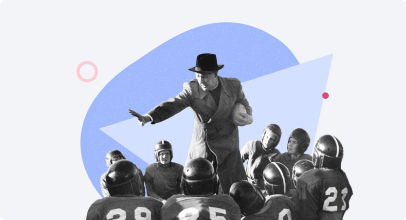What Is Adult Learning Theory and How to Use It in Corporate Learning
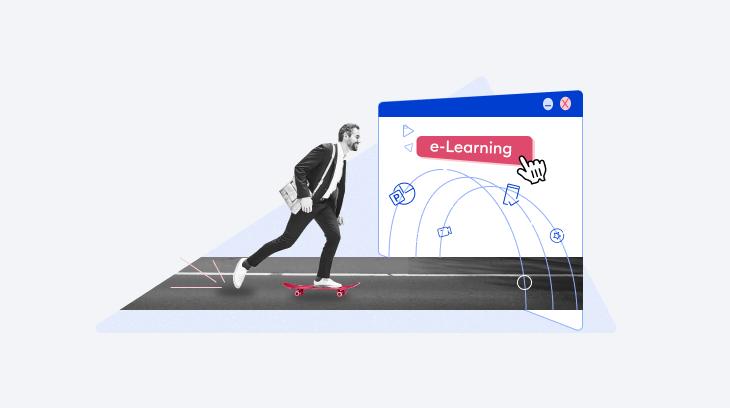
What motivates an adult to learn: curiosity or a simple need to know? Educational researchers have come up with an array of answers to that question over the years. The truth is that adults are complex individuals so there’s no one-size-fits-all answer.
This article explores key adult learning theories and principles of adult education, and explains how to teach adults effectively.
- What is an Adult Learning Theory?
- Difficulties in Adult Learning
- Learning Theory Comparison Chart
- Major Adult Learning Theories
- Best Adult Learning Techniques to Boost Engagement
- Useful Resources
What is an Adult Learning Theory?
Adult learning theory, or andragogy, is the study that examines how adults learn and master knowledge, competences, and new skills. Adult learning theory principles are based on the premise that adults learn differently than children. Here are some basic differences between teaching children and creating training for adults.
| Children | Adults |
| Child-oriented learning provides a basic foundation of knowledge and helps develop critical thinking skills. | Adults have an existing base of knowledge and life experience. Adult students seek out continuous learning based on personal interests, wants, and needs. |
| Younger learners typically have no choice but to study and may lose enthusiasm if they are not engaged in what is happening around them. | Unlike children, adult learners understand why they’re learning, so their motivation to learn is naturally high. |
| It’s necessary to be in charge of the classroom. | It’s beneficial to let adults work things out for themselves and organize themselves. |
| Teachers play a central role in delivering knowledge and guiding learning activities. | The role of “teacher” may be effectively filled by a mentor, coach, training facilitator, peer, or subject matter expert. |
Given that an adult brain is different, and adult learners have certain emotional baggage, life experiences and internal motives, this imposes specific challenges that most adults tend to face when it comes to learning and training. Let’s cover them briefly.
Difficulties in Adult Learning
These are the most common difficulties, or learning barriers, typically encountered by adult learners that can prevent adults from growing their skills and impact their readiness to learn. Since corporate learning takes the largest share in adult learning, we’ll cover adult learning barriers in that context.
Focusing
With only 5% of the workweek that employees are ready to spend on training (according to the most optimistic estimates), it’s evident that adults generally tend to have other priorities. They have too much on their plate, not only at work but in their personal life. That presents the challenge to stay focused on training and reduce distractions (e.g., noisy learning environment, children and pets demanding attention at home, or smartphone addiction).
Seeing the big picture
If adults don’t see where they stand in the company, don’t feel valued, or know what depends on them, corporate training often may seem unnecessary. Employees may simply not understand why their employer tries to involve them in corporate training programs. It’s necessary to show that employee training and development are important for their growth in the company and to make a real impact on overall business performance.
Having a purpose
That’s the same old ‘what’s in it for me’ situation. Adult learners want to know exactly how the new information will help them in life or work. If the purpose of training isn’t concrete enough and doesn’t target the learning needs of the audience, it may become an unbreakable barrier, and no training will make sense.
Imposter syndrome
Adults tend to fear not knowing something they perceive to be essential for their new role, another career path, or a different profession. Motivation to learn may decline due to the fear of criticism as well. So, if the training topic is something new for the adult, they may suffer from imposter syndrome, and that hinders their growth and professional development greatly.
To distinguish the critical aspects of adult learning, education theorists and psychologists had to elaborate theoretical frameworks that would reinvent learning experiences and practices for adults. Over the last century, a number of different theories have gained prominence. There’s no single theory that explains how and why adults learn best; however, each one sheds light on a particular aspect of adult learning.
We’ve made a review of six of the most popular adult learning theories to see how each can be used to facilitate adult learning techniques to deliver desired learning outcomes.
Learning Theory Comparison Chart
Here’s a comparison chart of the best learning theories for adults we will examine in the article. We hope it’ll help you select the best strategy for your own learning program design needs.
| CONCEPT | SUMMARY | BEST SUITED FOR |
| Andragogy |
|
|
| Transformational Learning |
|
|
| Experiential Learning |
|
|
| Self-Directed Learning |
|
|
| Project Based Learning |
|
|
| Action Learning |
|
|
Below is the detailed overview of these most popular adult learning theories.
Major Adult Learning Theories
Take an overall look at these adult learning theories to gain insight into what motivates adults to learn, and use this knowledge as a building block for your own development and instructional design efforts.
Andragogy
Introduced by educator Malcolm Knowles in 1968, the concept of andragogy is described by its creator as the art and science of helping adults learn. We’ve already covered the main assumptions of this adult learning concept when comparing adult and child learners. Malcolm Knowles elaborated the four main principles of adult learning that the andragogy theory is famous for.
| Principle | Practical example |
| Adults learn better from their experiences and their past knowledge should be taken into account. | When planning online courses or training classes for adults, try to appeal to their professional background, whatever it is, and provide related examples. Adults will learn new knowledge better if they link it to their life experiences. |
| Many adults favor a pragmatic approach, so learning should be problem-centered. | Clearly articulate the ‘why’ behind training and make it speak for itself. Anticipate the question “What’s in it for me?” and come up with relevant material. |
| Adults are most interested in learning things that have immediate relevance. | Blend theory with practice and create exercises and role-plays to apply new knowledge immediately. |
| Adults need to actively participate in the planning and evaluation of their instruction. | Involve your learners in the planning, execution, and assessment of the new training program. Collect their feedback and update the training material accordingly. |
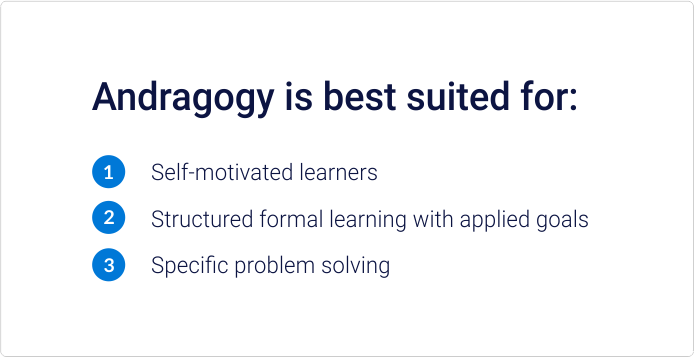
Transformational learning
Introduced by Jack Mezirow in 1978, transformative learning theory posits the concept that all learners use different assumptions, expectations, and beliefs to make sense of the world around them.
- Transformative learning attempts to help learners change — or transform — their existing frames of reference through a process of problem solving, procedural tasks, and self-reflection.
- Learning transformations occur when individuals face a “disorienting dilemma” that challenges their existing beliefs and critically reflect upon what has taken place.
- It’s considered one of the “stickiest” types of learning because it can shift an individual’s perspective on how to behave, interact, or problem solve.
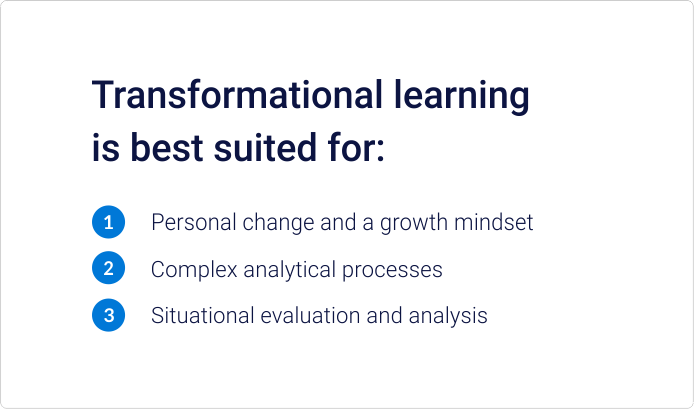
Experiential learning
Developed by David Kolb in the 1970s, by drawing on the work of John Dewey, Kurt Lewin, and Jean Piaget, experiential learning requires a hands-on approach that puts the learner at the center of the learning experience.
- Active participation is key, but the theory says that learning happens only when the individual reflects upon what they are doing.
- The four elements of experiential learning are active involvement, reflection upon practice, conceptualization of the experience, and use of knowledge gained from experience.
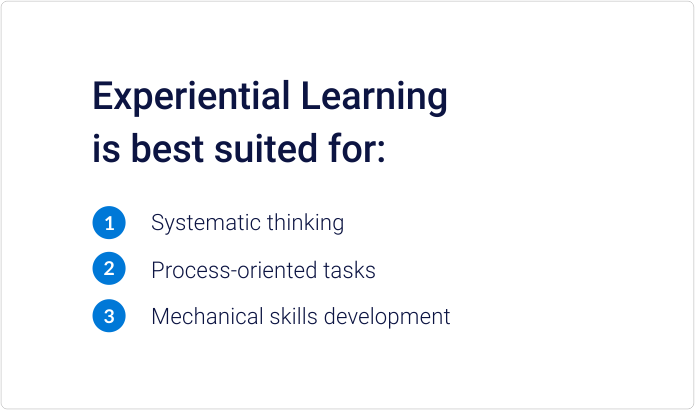
Self-directed learning (SDL)
SDL is rooted in Malcolm Knowles’ theory of adult learning; in 1997, D.R. Garrison added elements of self-management to the model.
- SDL is a process where individuals take the initiative to diagnose learning needs, form learning goals, identify resources, implement a learning plan, and assess their own results.
- SDL often occurs with the help of teachers, mentors, resources, and peers.
- Requires the learner to be able to access and select appropriate learning programs.
- The learner exercises control over all learning decisions.
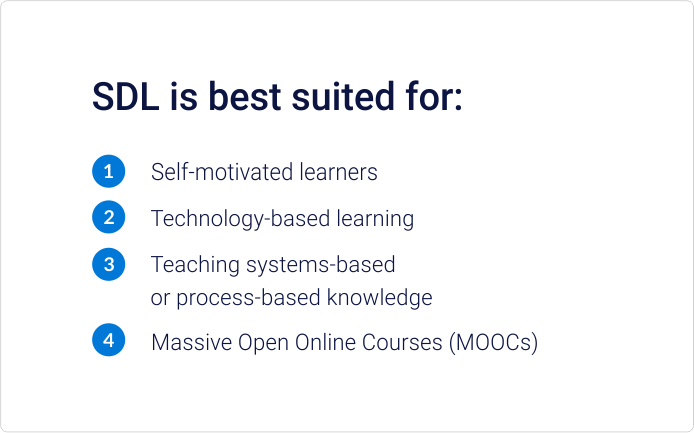
Project based learning (PBL)
Developed by John Dewey in 1897, project based learning theory holds that learners acquire the skills needed for deeper knowledge through active exploration of real-world problems. Dewey called this principle “learning by doing.”
- PBL requires learners to solicit feedback and continually review results. This iterative process is believed to increase the possibility of long-term retention of a new skill and knowledge.
- It requires the use of diverse skills, including inquiry, , problem solving, collaboration, and communication.
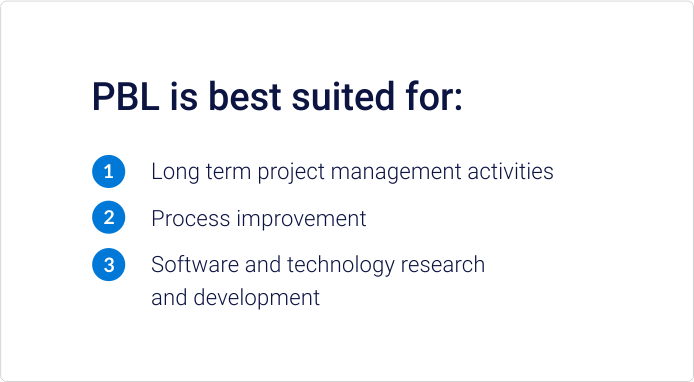
Action learning
Developed by Reg Revans in 1982, action learning is an approach to problem solving that involves taking action and reflecting on the results.
- The goal of action learning is to improve problem solving processes and simplify the resulting solutions.
- This approach tackles problems by first asking questions to clarify the problem, reflecting and identifying possible solutions, and only then taking action.
- Questions build group dialogue and cohesiveness, develop innovative and systems thinking, and improve learning results.
- Action learning requires that the group be able to take action on the problem it’s working on. If learners make recommendations only, the group loses its energy, creativity, and commitment.
- There should be a coach who helps the group to learn and work smarter and more effectively.
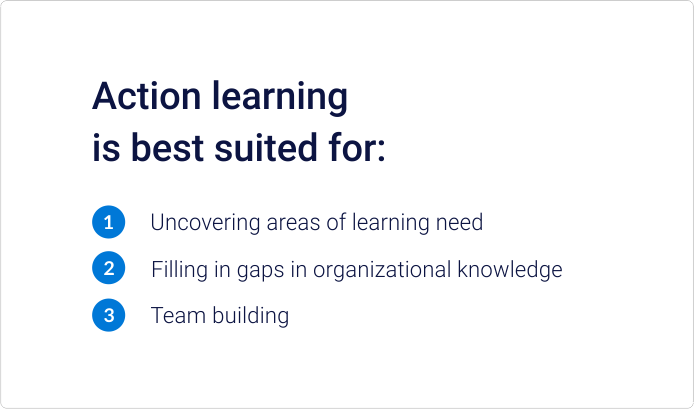
Best Adult Learning Methods to Boost Engagement
Whichever adult learning theory you choose as a training framework, enticing your learners is key. It doesn’t matter what you teach or instruct your learners on – the most effective techniques will focus on the psychology of learning and emotions.
Based on the adult learning theory and principles, as well as andragogy examples, we can provide actionable takeaways, or techniques, to drive your learners forward and facilitate a meaningful learning experience:
Involve learners in planning their learning
Evidence shows that by letting adults decide on their learning goals, you motivate them more.
Make it similar to problem-solving
Let your learners focus on the issue that can be fixed with the help of training or even in the very process of it.
Encourage critical reflection
Ask learners to give feedback, express opinions, discuss results, and draw personal conclusions. Introduce self-evaluation and growth mindset to enable learners to track the progress of their own learning and review their own goals.
Allow autonomy
A certain extent of control over training will be a good aid to motivation. Try to introduce self-directed and self-paced learning scenarios into everyday lives.
Appeal to the learners’ emotional side
Try not to only deliver practical knowledge, but also engage learners emotionally and ignite their thought.
Create a story
Leverage elements of storytelling and introduce characters that will accompany learners all the way and overcome certain challenges related to the new topic.
Provide inspiring examples
Share about others who took part in training and what results they achieved.
Stimulate with intrinsic rewards
Extrinsic motivation is important, but it’s essential to position your training as a way of feeling the joy of learning and getting a sense of self-achievement.
These techniques are the ways to attract and retain your learners’ attention and motivate them to proceed with training and complete the course. However, you need to keep in mind that they should be well-suited to the learning material and directly related to the topic.
Below, you’ll find out how to work with the learning material for adults in the most effective way.
To Sum Up
Instructional designers can use the principles of adult learning theories as a basis for their overall learning architecture. Once you have chosen the best-fit learning approach, a robust authoring tool can help you create a learning activity that develops job-essential skills and knowledge. Download a free iSpring Suite trial and explore all its features right now.
Useful Resources
Check out some more articles about adult learning in our blog:
- The 11 Best HR Tools for Streamlining Your Workflow in 2023
- What is eLearning and How It Benefits Businesses
- 70:20:10 Learning Model: How to Enhance it with Technology
- 5 Types of Employee Training and How to Get Improved Results with eLearning
- 12 LMS Benefits For Recruiters, HR, Sales and Commercial Directors—Expert Opinion








